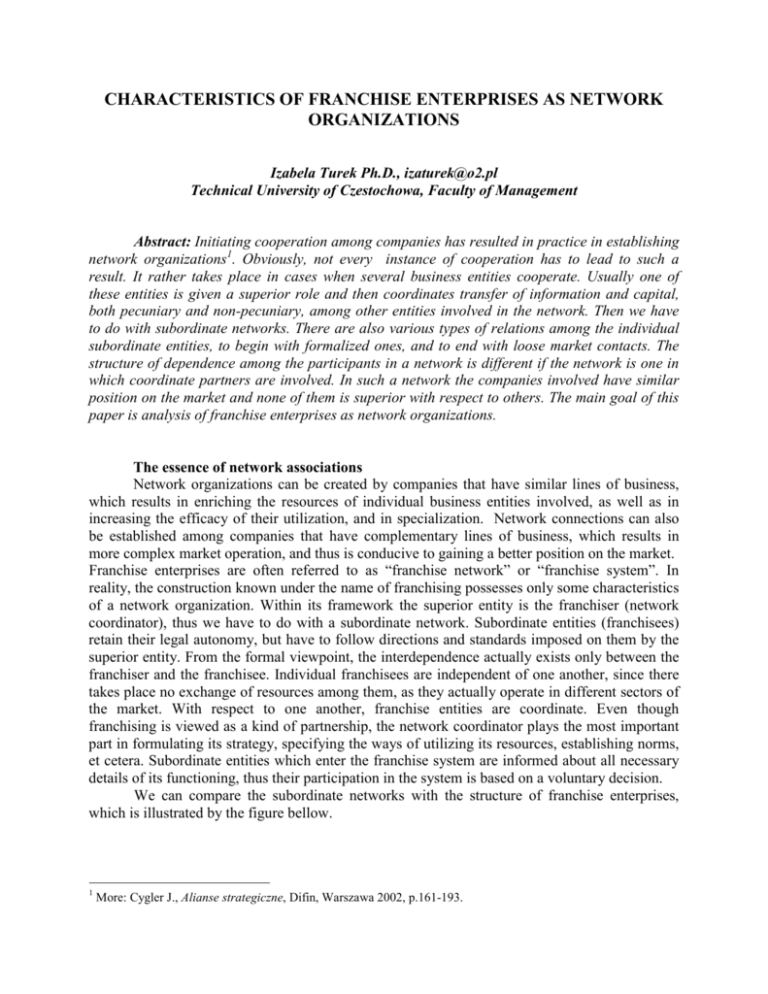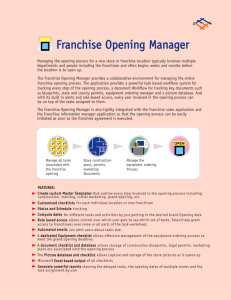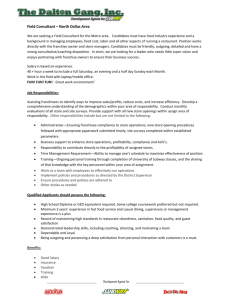characteristics of franchise enterprises as network organizations
advertisement

CHARACTERISTICS OF FRANCHISE ENTERPRISES AS NETWORK ORGANIZATIONS Izabela Turek Ph.D., izaturek@o2.pl Technical University of Czestochowa, Faculty of Management Abstract: Initiating cooperation among companies has resulted in practice in establishing network organizations1. Obviously, not every instance of cooperation has to lead to such a result. It rather takes place in cases when several business entities cooperate. Usually one of these entities is given a superior role and then coordinates transfer of information and capital, both pecuniary and non-pecuniary, among other entities involved in the network. Then we have to do with subordinate networks. There are also various types of relations among the individual subordinate entities, to begin with formalized ones, and to end with loose market contacts. The structure of dependence among the participants in a network is different if the network is one in which coordinate partners are involved. In such a network the companies involved have similar position on the market and none of them is superior with respect to others. The main goal of this paper is analysis of franchise enterprises as network organizations. The essence of network associations Network organizations can be created by companies that have similar lines of business, which results in enriching the resources of individual business entities involved, as well as in increasing the efficacy of their utilization, and in specialization. Network connections can also be established among companies that have complementary lines of business, which results in more complex market operation, and thus is conducive to gaining a better position on the market. Franchise enterprises are often referred to as “franchise network” or “franchise system”. In reality, the construction known under the name of franchising possesses only some characteristics of a network organization. Within its framework the superior entity is the franchiser (network coordinator), thus we have to do with a subordinate network. Subordinate entities (franchisees) retain their legal autonomy, but have to follow directions and standards imposed on them by the superior entity. From the formal viewpoint, the interdependence actually exists only between the franchiser and the franchisee. Individual franchisees are independent of one another, since there takes place no exchange of resources among them, as they actually operate in different sectors of the market. With respect to one another, franchise entities are coordinate. Even though franchising is viewed as a kind of partnership, the network coordinator plays the most important part in formulating its strategy, specifying the ways of utilizing its resources, establishing norms, et cetera. Subordinate entities which enter the franchise system are informed about all necessary details of its functioning, thus their participation in the system is based on a voluntary decision. We can compare the subordinate networks with the structure of franchise enterprises, which is illustrated by the figure bellow. 1 More: Cygler J., Alianse strategiczne, Difin, Warszawa 2002, p.161-193. Figure 1. Comparison of the subordinate networks with the structure of franchise enterprises Source: Own study on the ground: Cygler J., Alianse strategiczne, Difin, Warszawa 2002, p. 167. FRANCHISEE FRANCHISEE FRANCHISEE FRANCHISOR FRANCHISEE FRANCHISEE FRANCHISEE FRANCHISEE FRANCHISEE Source: Own study. Comparison of structure network organizations and franchise enterprises we can observe that one of the partner takes the subordinate position. The difference is in fact that in franchise enterprises every franchisees have the same range and in network organizations the position of remaining partners can be differentiated. Rules and advantages of establishing network organizations in the context of franchising There are four general rules of establishing enterprises based on the network system2: − specialization; i.e. the concentration of individual entities in the areas that are best known to them; establishing new franchise entities takes place with the help of the franchisee who is familiar with the conditions of the local market, − autonomy; the links of the chain must have the freedom of making decisions concerning their operation; the autonomy of franchise entities is limited; the franchisee retains the 2 On the ground: Zeller P., Sieci franchisingowe, Zeszyty Naukowe nr 9: Rogoziński K., Transformacja w usługach, Wydawnictwo Akademii Ekonomicznej w Poznaniu, Poznań 2001, p. 140. freedom of acting only within the limits specified by the contract of franchising, but at the same time retains legal autonomy in its relationship with the system coordinator, − cooperation; the network is a closed system of mutual cooperation; in franchise networks the system of cooperation is not always closed, as various solutions can be adopted in this sphere, − market criteria; understanding that the operation of every link depends on other participants of the market (network), and the contacts among them are established according to market criteria; in franchise networks there is no direct financial dependence among particular participants, but proper care for the good reputation of an outlet is parallel to establishing the good reputation of the whole network, thus maintaining specified standards is an implicit obligation of every franchisee. The advantages of functioning within a franchise network are largely the same as the advantages connected with functioning within a network organization. They include reduction of risk, increased flexibility, an opportunity for acquiring new capacity for development, facilitated access to scarce sources and skills, increased speed of operation, facilitated acquisition of information3. Reduction of risk is a basic advantage resulting from franchising. Prior to proposing a possibility of cooperation to other entities, the network coordinator must test his policy on the market and prove its effectiveness. Then the development of a network through making an idea available for other entities provides a chance for reducing risk. The new network participant joins a structure whose effectiveness has already been proved, takes over standards that have proved to be correct, benefits from the recognized trademark, et cetera. Such a situation certainly involves less risk than starting a business activity on one’s own. However, it has to be stressed once again that reduction of risk is possible only when the franchiser has an effective idea to offer, and it is not an attempt at rescuing their company by utilizing the resources of franchisees. It happens very rarely that an idea which has not been tested on the market proves to be effective in franchise activity. It can only take place in the case when the idea is truly unique and the franchiser has just spotted an occasion to introduce it, which has to be done as soon as possible in order to get in front of competition. Increasing the flexibility in company operation in rough market environment is almost becoming a necessity nowadays. It can be noticed that the vertically integrated structures show less flexibility than network structures. Franchise systems are vertical structures, but their expansion in this direction is of limited character. Usually there comes into being the first level, on which there function the organizer of the whole system and the headquarters of the company, and the second level, including franchisees, who remain in coordinate relationship. Thus the flow of information takes place only between these two levels, which is not an obstacle taking into account the extent to which information technology is nowadays utilized by modern companies. A more serious difficulty might be if there arose a necessity to change the line of business, since for a number of entities whose line of business is exactly the same, it would be connected with serious expenses. In such a case the flexibility is seriously limited. In franchise enterprises, the possibility to acquire new capacity for development shows through the expansion of a given company by utilizing financial resources, skills, and the 3 Child J., Faulkner D., Strategies of Co-operation. Managing Alliances, Networks, and Joint Ventures, Oxford University Press, Oxford 1998, p. 114-115 in: Cygler J., Organizacje sieciowe jako forma współdziałania plrzedsiębiorstw: Romanowska M., Trocki M. (red.), Przedsiębiorstwo partnerskie, Difin, Warszawa 2002, p. 152154. acquaintance with local market of particular franchisees. It is usually a quicker and safer way of development than utilizing the franchiser’s own resources and not making the outline of action available for other entities. A spectacular example of this is the McDonald’s network of restaurants, inaugurated in 1955. In the following years the network was subject to very fast development and two years later there functioned 37 restaurants run by franchisees; in the year 1969 there were 1000, in 1972 – 2000, in 1980 – 5000, and in 1992 – 8000. A similar network of hamburger bars, called White Castle, had come into being at the beginning of the twentieth century. Its owners decided to follow the course of slow development, financing the establishment of new restaurants solely from profits, and not selling the license to any other entities. Seventy years later the network consisted of about 300 restaurants. It must also be stressed that White Castle has never become a trademark recognizable to such a wide extent as McDonald’s, and it needed twice as much time for achieving the results thirty times less spectacular than McDonald’s4. Some kinds of business activity, combined with favourable market conditions, yield very good results if franchising is applied as a strategy for development. Resignation from the chance it provides is tantamount to being left behind the competitors. An opportunity of facilitated access to scarce resources and skills in network organizations is due to the fact that the resources and skills of partners operating within such a network are complementary. In franchise networks the advantage is of a slightly different kind from the point of view of the franchiser, since all franchisees are supposed to have at their disposal similar resources and skills. However, their acquaintance with the local market is important, as is making them responsible for the recruitment of staff to be employed in their outlet. It happens extremely rarely that employees for a specific outlet are recruited by the network coordinator. From the point of view of a franchisee, it is advantageous that the franchiser provides professional help and consulting, makes available the results of research carried out by the headquarters, and organizes promotional and advertising campaigns. Furthermore, the network as a whole has a more powerful bargaining position, which means that it can negotiate better conditions for supply, preferential conditions for crediting, and apply for better localizations. Increased speed of action is an advantage resulting from the fact that entities involved in a network have facilitated access to scarce resources and skills, as well as from the fact that particular entities within the network are specialized in different areas. However, in the case of franchise networks this rule does not apply completely, which has also been mentioned while discussing the flexibility of a network organization. It results from the fact that all initiatives are actually undertaken by the network coordinator, who has at his disposal a large reserve pool mostly coming from franchisees, which provides an opportunity for its fast mobilization. Therefore, the analyses carried out, and the projects introduced, are more effective and can be put into practice faster than in companies which operate as single business entities. If the changes introduced are not very extensive or they result from current policy of the network, they can be introduced simultaneously in all entities functioning within the network, having provided earlier detailed instructions containing directions for the performance of a particular task. Information acquisition under present day economic conditions is a very significant mode of action. The acquired information ought to be complete and up-to-date, and conclusions drawn from it ought to be utilized in due time. In network organizations information can be exchanged 4 On the ground: Kolarski G., Franchising. Przewodnik dla początkujących, Centrum Informacji Menedżera, Warszawa 1992, p. 5-6. among particular partners within the network, as well as be acquired by them from the market environment. Cumulating resources that are utilized for research provides an opportunity for acquiring more complex data and a better interpretation of the acquired data. In companies operating within a franchise network there can be differentiated three basic types of information flow: gathering information from market environment directly by the centre of the network, providing information on the local markets by particular entities involved in the network, and internal flow of information between the franchiser and franchisees, based on positive feedback. Information gathered from the market environment by the network coordinator either originates from his own research, or is acquired from specialized firms, or comes from franchisees. In most cases there is no flow of information from the franchiser to franchisee. It is relayed in the indirect form of guidelines, plans to be realized, instructions on the mode of action to be taken, et cetera. Thus, we have to do with internal flow of information in this case. Internal information from franchisees has the form of accounts, sale reports, reports on the realization of promotional campaigns. Information on the market environment is acquired by the franchisee from the local market and passed on to the headquarters. It can concern such issues as the prices offered by major competitors, the appearance of new competitors, regional events, a number of customers served on a particular day, and other issues which are important from the point of view of a specific line of business. In franchise systems there are no formal information channels among particular outlets and no formal hierarchical relationships among them. However, the flow of information can take place informally, for instance on telephone, by e-mail or during a discussion at a meeting of franchisees. The achieve analysis shows that the franchising enterprises are based on the network organizations rules. Bibliography: 1. Child J., Faulkner D., Strategies of Co-operation. Managing Alliances, Networks, and Joint Ventures, Oxford University Press, Oxford 1998, p. 114-115 in: Cygler J., Organizacje sieciowe jako forma współdziałania plrzedsiębiorstw: Romanowska M., Trocki M. (red.), Przedsiębiorstwo partnerskie, Difin, Warszawa 2002. 2. Cygler J., Alianse strategiczne, Difin, Warszawa 2002. 3. Hall P., Dixon R., Franchising, Pitman, London 1988. 4. Kolarski G., Franchising. Przewodnik dla początkujących, Centrum Informacji Menedżera, Warszawa 1992. 5. Mendelsohn M., Acheson D., Franchising, Poltext, Warszawa 1992. 6. Zeller P., Sieci franchisingowe, Zeszyty Naukowe nr 9: Rogoziński K., Transformacja w usługach, Wydawnictwo Akademii Ekonomicznej w Poznaniu, Poznań 2001.









